Alkene reactions Study guides, Class notes & Summaries
Looking for the best study guides, study notes and summaries about Alkene reactions? On this page you'll find 304 study documents about Alkene reactions.
Page 3 out of 304 results
Sort by
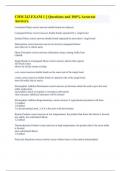
-
CHM 242 EXAM 1 || Questions and 100% Accurate Answers.
- Exam (elaborations) • 5 pages • 2024
-
- $10.59
- + learn more
Cumulated Diene correct answers double bonds are adjacent Conjugated Diene correct answers double bonds separated by 1 single bond Isolated Diene correct answers double bonds separated by more than 1 single bond Heteroatoms correct answers may be involved in conjugated dienes atom that isn't a carbon atom Diene Formation correct answers elimination using a strong, bulky base t-BuOK Single Bonds in Conjugated Diene correct answers shorter than typical will freely rotate allows...
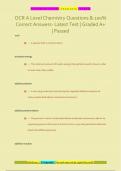
-
OCR A Level Chemistry Questions & 100% Correct Answers- Latest Test | Graded A+ | Passed
- Exam (elaborations) • 33 pages • 2024
-
- $12.99
- + learn more
acid ֎ -:- A species that is a proton donor. activation energy ֎ -:- The minimum amount of kinetic energy that particles need to have in order to react when they collide addition polymer ֎ -:- A very long molecular chain formed by repeated addition reactions of many unsaturated alkene molecules (monomers). addition polymerisation ֎ -:- The process in which unsaturated alkene molecules (monomers) add on to a growing polymer chain one at a time to form a very long saturated molecu...
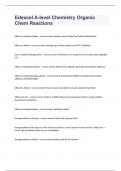
-
Edexcel A-level Chemistry Organic Chem Reactions Question and answers 100% correct 2023/2024
- Exam (elaborations) • 4 pages • 2024
-
Available in package deal
-
- $13.99
- + learn more
Edexcel A-level Chemistry Organic Chem Reactions Question and answers 100% correct 2023/2024Alkane to Halogenoalkane - correct answer Halogen and UV light (free radical substitution) Alkene to Alkane - correct answer Hydrogen gas, Nickel catalyst and 150°C (addition) Use of catalytic hydrogenation - correct answer Manufacture of margarine from unsaturated vegetable oils Alkene to Dihalogenoalkane - correct answer Add bromine LIQUID and shake (electrophilic addition) Alkene to hydro
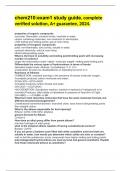
-
chem210:exam1 study guide, complete verified solution, A+ guarantee, 2024.
- Summary • 6 pages • 2024
-
Available in package deal
-
- $10.49
- + learn more
chem210:exam1 study guide, complete verified solution, A+ guarantee, 2024. properties of organic compounds non-polar; flammable; covalent bonds; insoluble in water; carbon containing molecules; non-conductor in electrolytes; LOW boiling and melting points; gas at room temp. properties of inorganic compounds polar; non-flammable; ionic bonds; soluble in water; conducts electricity; solid at room temp; HIGH boiling/melting points What is the trend in solubility and boiling point/melting...
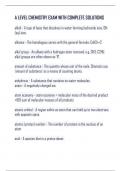
-
A LEVEL CHEMISTRY EXAM WITH COMPLETE SOLUTIONS alkali - A type of base that dissolves in water forming hydroxide ions, OH- (aq) ions. alkanes - The homologous series with the general formula: CnH2n+2. alkyl group - An alkane with a hydrogen atom
- Exam (elaborations) • 42 pages • 2024
-
- $20.49
- + learn more
A LEVEL CHEMISTRY EXAM WITH COMPLETE SOLUTIONS alkali - A type of base that dissolves in water forming hydroxide ions, OH- (aq) ions. alkanes - The homologous series with the general formula: CnH2n+2. alkyl group - An alkane with a hydrogen atom removed, e.g. CH3, C2H5; alkyl groups are often shown as 'R'. amount of substance - The quantity whose unit of the mole. Chemists use 'amount of substance' as a means of counting atoms. anhydrous - A substance tha...
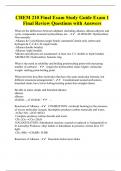
-
CHEM 210 Final Exam Study Guide Exam 1 Final Review Questions with Answers
- Exam (elaborations) • 18 pages • 2023
-
Available in package deal
-
- $10.99
- + learn more
What are the differences between aliphatic (including alkanes, alkenes,alkynes and cyclic compounds) aromatic hydrocarbons are. - ALIPHATIC Hydrocarbon: Non-aromatic -Alkanes & CycloAlkanes:single bonds; saturated:Contain only carbon and hydrogen & C-C & C-H single bonds -Alkenes:double bond(s) -Alkynes: triple bond(s) *alkenes and alkynes are unsaturated: at least one C-C double or triple bond(s) AROMATIC Hydrocarbon: benzene ring What is the trend in solubility and boiling point/mel...
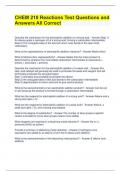
-
CHEM 210 Reactions Test Questions and Answers All Correct
- Exam (elaborations) • 3 pages • 2024
-
Available in package deal
-
- $12.99
- + learn more
CHEM 210 Reactions Test Questions and Answers All Correct Describe the mechanism for the electrophilic addition of a strong acid. - Answer-Step 1) An alkene grabs a hydrogen off of a strong acid, forming a carbocation intermediate. Step 2) The conjugate base of the acid (an anion now) bonds to the open shell carbocation What is the regioselectivity of electrophilic addition reactions? - Answer-Markovnikov What is Markovnikov regioselectivity? - Answer-States that the major product is det...
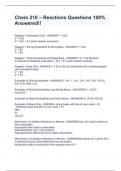
-
Chem 210 – Reactions Questions 100% Answered!!
- Exam (elaborations) • 6 pages • 2024
-
Available in package deal
-
- $10.99
- + learn more
Chem 210 – Reactions Questions 100% Answered!! Reagent = Nucleophile Only - ANSWER1° = Sn2 2° = Sn2 3° = Sn1 + E1 (polar medium necessary) Reagent = Strong Nucleophile & Strong Base - ANSWER1° = Sn2 2° = E2 3° = E2 Reagent = Weak Nucleophile and Weak Base - ANSWER1°/2° = No Reaction 3°/resonance stabilized carbocation = Sn1 + E1 (polar medium necessry Reagent = Base Only - ANSWER1° = E2 or Sn2 (if unhindered and no beta-hydrogen with unhindered base) 2° = E2 3° = E...
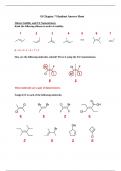
-
CHM 2210 SI Chapter 7 Handout Answer Sheet
- Other • 11 pages • 2023
-
- $17.49
- + learn more
SI Chapter 7 Handout Answer Sheet Alkene Stability and E/Z Nomenclature Rank the following alkenes in order of stability. 6 > 4 > 3 > 1 > 2 > 7 > 5 How are the following molecules related? Prove it using the E/Z nomenclature. These molecules are a pair of diastereomers. Assign E/Z to each of the following molecules. Assign E/Z to the following molecules. Name each of the following molecules using IUPAC nomenclature. Elimination Reactions Complete the general reaction ...

-
BCH 462 Exam 4 Questions With 100% Correct Answers
- Exam (elaborations) • 20 pages • 2024
-
- $13.49
- + learn more
BCH 462 Exam 4 Questions With 100% Correct Answers Fatty Acid Synthesis - answerFatty acids are built in several passes, processing one acetate unit at a time. The acetate is coming from activated malonate in the form of malonyl-CoA. Each pass involves reduction of a carbonyl carbon to a methylene carbon. Overall, repeating four-step sequence that elongates the fatty acyl chain by two carbons at each step, uses NADPH as the electron donor. Two enzyme-bound -SH groups serve as activating...

How much did you already spend on Stuvia? Imagine there are plenty more of you out there paying for study notes, but this time YOU are the seller. Ka-ching! Discover all about earning on Stuvia


